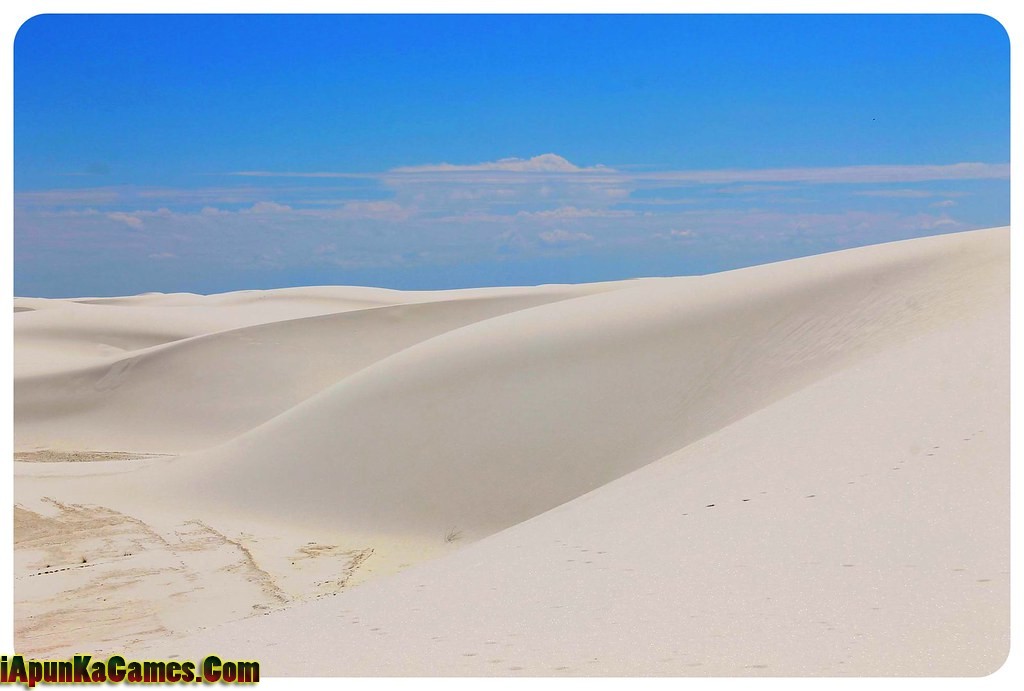All of a sudden, the highway where we had been driving for the last 30 minutes became surrounded by tall, sandy dunes. White Sands, New Mexico.
This was a surreal moment, since we had been driving in the barren desert of Southern New Mexico for a while without even seeing any sand dunes yet, and within minutes, we were surrounded by them completely.
Our drive into the dunes started out great, with a beautiful view of the vibrant desert. We couldn’t believe how far we went before footsteps in the sand guided us to a point where the road was completely covered by sand. We were driving through a sand desert by then.
The white sand dunes of New Mexico were one of the things we were most excited about when we planned our New Mexico road trip – you might have seen them in music videos like Boyz II Men’s “Water Runs Dry” or P. Diddy’s Best Friend – and while sand dunes are certainly not uncommon, they’re particularly rare to find ones that are bright white.
The azure blue New Mexico skies add a beautiful contrast to the white and blue of the stars.
The sand dunes sit at the northern end of the Chihuahuan Desert in the Tularosa Basin, and they include an estimated area of 710km2 (275mi2). We learned from our visitors’ brochure that they had actually all been part of a massive lake during the last ice age.
After the lake dried up, it left a large area of selenite (gypsum in crystalline form). Over many years, the winds blew over this area, which then turned into sand-sized grains that get broken down as they’re continually moved by erosion and weathering. The winds eventually formed the sand dunes.
This is why it’s nearly impossible to find any plants in White Sands New Mexico – if the plants are not very resistant and fast-growing, they get blown over by the moving sand quickly and don’t survive.
As the dunes change, plants and flowers may get covered in sand and disappear in some areas. This is because the shape of changes slowly as it moves further into the dunes for a variety of reasons that vegetation can’t escape.
There’s a lot of wildlife to be found in this beautiful part of the world, if you know where to look. There are plenty of plants, especially when it’s wetter outside – but only a few animals that can be seen as anything except rocks and sand.
We entered the forest and were surprised by what we saw. The only sign of life was a lonely black little beetle.
The area’s tumbleweed-ridden dunes felt like a haven from the rest of the world. Even though it seemed full of cars, once you got one of the hiking trails that lead away from the street into the sand dunes, you were alone.
White Sands is a 7,000-acre (2800 ha) area managed by the US Army Corps of Engineers. The trail was originally designed to enable hikers and the military alike to traverse it in both directions without having to go back for their car at any point (4.5 miles / 7.2 km). It starts out easy enough, but as we reached the end after about 20 minutes, the sun was bearing down on us with temperatures above 100 °F / 38 °C.
We were experienced and well-prepared for the hike, so we set off on our way despite the sunny and scorching conditions.
We were surrounded by white sand dunes and could no longer see the street we came in on after five minutes of following the orange tape.
When you’re in unfamiliar territory, it’s easy to make bad decisions. That was the case for hikers who got lost in White Sands National Park due to underestimated the heat and difficulty of the terrain.
Hikers should take care to stay on the path, in order to avoid getting lost and leaving exhausted in the heat or dehydrated. In fact, several hikers have gone lost in White Sands, underestimating their abilities to walk without water or overestimating the heat.
From the moment we arrived, it was easy to think that there’s so much snow surrounding us – even though we could feel the sweat dripping down our forehead. We returned to the parking area, and when we got there, there was also a huge picnic area outfitted with futuristic-looking silver tables. As it turned out, these shaded areas were all that existed in the dunes!
Many of the sand dunes can be tall enough to enjoy a ride down on a sled or even a sandboard. We had missed our chance to pick up a sled at the visitor center, but it was still fun to watch other visitors board and sled down the dunes.

